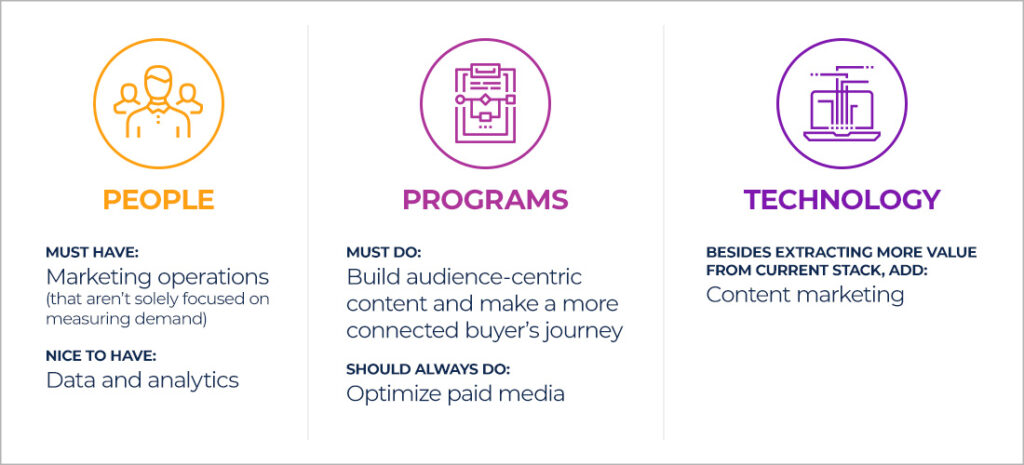For our 2024 investment insights report, Iron Horse polled 400 B2B marketing decision-makers to find out the most important business outcomes they’re focused on with their next planned investment. Regardless of how we cut the data, the results were the same. B2B marketing leaders are prioritizing three outcomes with their next investment: improving efficiency, increasing retention of current customers, and driving expansion (via cross-sell/upsell) within existing accounts.
Conversely, planned investments for net new logo acquisition never reached the top three. This does NOT mean organizations are turning away from new logo acquisition as a critical means for growth! Instead, our data indicates high growth (i.e., grew annual revenue 11%-40%, n=252) B2B marketing organizations recognize the need for better balance across net new, retention, upsell and cross-sell revenue streams.
Upon further analysis, what emerged were significant similarities in the people, programs and technology needed to achieve all three of those outcomes. This begs the question, why settle for just one outcome when you can aim for all three? Whether your most important outcome with the next planned investment is efficiency, retention, or expansion business, high growth companies plan to invest in the following:

If your organization is similarly prioritizing efficiency, retention or expansion business, you can’t go wrong by following the lead of these high-growth marketing leaders. I thought it would be interesting to take things a step further and consider how B2B marketing organizations can leverage artificial intelligence (AI) to help achieve these goals. (For fun, I started by asking ChatGPT—and was gratified to see that I agreed with its analysis.)
As we saw with people, programs, and technology, the top three ways to use AI are largely the same regardless of outcome. Here they are:
1. Use AI to support personalization.
Personalize at scale.
AI can help create dynamic content recommendations, email campaigns and website experiences that are highly relevant to each buyer or customer—increasing engagement and improving the chances of progressing buyers along the journey towards conversion.
Increase retention with relevant content.
By analyzing historical customer data and real-time interactions, AI can identify opportunities for personalized content, product recommendations and marketing messages for existing customers. This fosters a sense of connection, increasing the likelihood of retention.
Drive expansion with highly targeted offers.
AI can segment your existing customer base into smaller, more targeted groups based on various attributes and behaviors. This segmentation allows you to tailor marketing messages, content and offers to specific segments within current accounts, increasing the relevance of your communications.
2. Put predictive analytics to work for growth.
Forecast more efficiently.
AI can process large datasets and identify patterns that human marketers might miss. By analyzing historical data and real-time market trends, AI can provide more accurate sales forecasts. It can also help optimize marketing budgets, and recommend the most effective marketing strategies and delivery channels so resources are allocated more efficiently.
Retain by predicting churn.
By examining factors such as usage behavior, purchase history and customer interactions, AI can provide early warning signs of potential churn. Predictive analytics powered by AI can also help optimize pricing and subscription models to keep customers engaged.
Expand based on history and behavior patterns.
AI can analyze historical data and customer behavior patterns to predict which products or services existing customers are most likely to be interested in. By leveraging machine learning algorithms, AI can provide personalized product recommendations and pricing strategies, enabling marketing teams to upsell and cross-sell effectively. This helps increase the average order value and expand revenue from existing accounts.
3. Take advantage of AI-powered chatbots.
Enlist efficient “frontline workers.”
AI-driven chatbots/virtual assistants operate 24/7 and can engage with website visitors, answer common questions, qualify leads, and even schedule appointments or demos. AI can also help with lead qualification by continuously monitoring and updating lead scores based on chatbot user behavior and engagement patterns.
Retain through enhanced customer experiences.
AI-driven chatbots can gather valuable customer feedback, helping marketers better understand their clients’ needs and preferences. This information can be used to refine marketing strategies and improve the overall customer experience, ultimately leading to higher retention rates.
Expand by automating customer support.
By automating routine customer interactions, your sales and support teams can focus on more strategic tasks, such as nurturing relationships and identifying upsell opportunities. This efficiency can lead to higher customer satisfaction and, ultimately, increased revenue from existing accounts.
The Iron Horse insight.
As with most innovation trends, the decision of how far down the AI journey to go begins by establishing clear business objectives. Rather than asking the question, “how can our company use AI?”, it’s better to reframe as “our company growth strategy is [efficiency/retention/expansion] and these are the specific use cases where AI can make a meaningful impact to [efficiency/retention/expansion].” Then the readiness assessment begins by evaluating your technology and integrations, ensuring the quality of your data, and cultivating a culture of innovation that lays the foundation for the successful adoption of AI.



